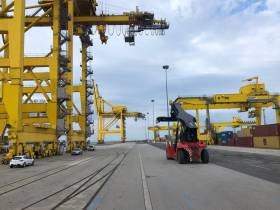Displaying items by tag: Connectivity
Embracing connectivity is the theme of the third Pillar I workshop for the Atlantic Action Plan: ports as gateways and hubs for the blue economy.
Connectivity: Staying Connected for Trade, Tourism and Economic Growth takes place online on Thursday 16 September from 9.30am to 12.15pm IST. See the workshop agenda HERE.
The workshop will be examining the significance of connectivity in promoting trade, tourism and economic growth in the maritime transport sphere.
It will focus on the Atlantic area and highlight post-Brexit issues, digitisation, the growing importance of regional ports and regional development in general.
To take part, complete the registration form by Tuesday 14 September.
Connectivity of Port-Rail Must be Strengthened in EU Policy
Experts from both sea and inland ports over the last year, have been assessing the European railway legislation from a port perspective. This has resulted in a position paper adopted by the European Sea Ports Organisation (ESPO) and the European Federation of Inland Ports (EFIP).
The joint position paper “Ports in the European Rail System” comes to five main conclusions:
The implementation of the current EU legislative rail framework should recognise that port authorities manage a complex web of transport, logistics, industry, energy, blue growth and community interests and rail management is generally not their core task. Moreover, the set-up of rail systems in European ports varies considerably in terms of infrastructure development and management, rail operation, charging systems and contractual relations between the port authority and rail operators or undertakings, which makes a one-size-fits-all approach unfit.
European ports are at the heart of multimodality. Efficient rail operations and links to and from the ports, as well as within the port, are essential to maximise the use of rail as a sustainable transport mode and to comply with the priorities set in the TEN-T legislation.
A special focus should be placed on the investment in, and the development of, last-mile connections, connecting the national rail network via the port rail network to the private terminal sidings. The future Connecting Europe Facility (CEF II) and future CEF II calls should prioritise last-mile connections inside and outside the port area as a priority and Member States should remove any legal or governance obstacle hampering the development of these connections.
The principle of autonomous charging has been laid down in the recently adopted Port Services Regulation (EU) 2017/352. For both sea and inland ports, port infrastructure charges are an important tool to pursue their economic, social and environmental strategies. In order to incentivise the use of rail transport, port managing bodies should remain free to choose an integrated or separate rail charging model, as long as it is transparent and non-discriminatory for the rail users.
Both sea and inland ports are predominantly situated in, or nearby, urban agglomerations. Freight transport by rail has a good environmental performance and is an effective means to reduce road congestion in densely populated areas. In order to maximise its potential the allocation of high quality freight train paths to and from European ports has be increased.
“Seaports are the gateways to Europe. As the entry and exit points to the land-based TEN-T network, they are at the crossroads of supply chains. To function at their best, European ports must rely on efficient and sustainable hinterland connections; rail can play an important role in that. The work of the port rail expert group has put the finger on some issues that hamper the seamless railway connectivity to and from ports. I hope we can work in the coming years on stepping up our efforts to have our concerns better reflected in the legislation. At the same time, I hope we can step up the dialogue with the rail sector and look at rail as a part of the logistic and supply chain, and not as a solution by itself. Improving the port-rail connectivity to enable efficient cargo flows should be seen as an important element of the completion of the TEN-T”, says ESPO Secretary General Isabelle Ryckbost.
“Inland ports are enablers of green logistics across Europe. As a climate friendly mode of transport, rail is an essential part of that. Rail and inland waterway transport together represent the most optimal, green transport combination. New rail connections and initiatives allow inland ports to connect to markets across the Eurasian continent. It is therefore invaluable that EFIP and ESPO together share their expertise and experiences to identify the port specific issues for rail connectivity. In this way we intend to deepen our cooperation with the rail sector even further and find ways to mutually support each other in tackling Europe’s green logistics challenges”, stated EFIP Director Turi Fiorito.






























































